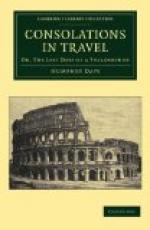Eub.—The grotto now becomes really magnificent; I have seen no subterraneous cavity with so many traits of beauty and of grandeur. The irregularity of its surface, the magnitude of the masses broken in pieces which compose its sides, and which seem torn from the bosom of the mountain by some great convulsion of nature, their dark colours and deep shades form a singular contrast with the beauty, uniformity, I may say, order and grace of the white stalactical concretions which hang from the canopy above, and where the light of our torches reflected from the brilliant or transparent calcareous gems create a scene which almost looks like one produced by enchantment.
Phil.—If the awful chasms of dark masses of rock surrounding us appear like the work of demons who might be imagined to have risen from the centre of the earth, the beautiful works of Nature above our heads may be compared to a scenic representation of a temple or banquet hall for fairies or genii, such as those fabled in the Arabian romances.
The Unknown.—A poet might certainly place here the palace of the King of the Gnomes, and might find marks of his creative power in the small lake close by on which the flame of the torch is now falling, for there it is that I expect to find the extraordinary animals which have been so long the objects of my attention.
Eub.—I see three or four creatures, like slender fish, moving on the mud below the water.
The Unknown.—I see them; they are the Protei. Now I have them in my fishing-net, and now they are safe in the pitcher of water. At first view you might suppose this animal to be a lizard, but it has the motions of a fish. Its head and the lower part of its body and its tail bear a strong resemblance to those of the eel; but it has no fins, and its curious bronchial organs are not like the gills of fishes: they form a singular vascular structure, as you see, almost like a crest, round the throat, which may be removed without occasioning the death of the animal, which is likewise furnished with lungs. With this double apparatus for supplying air to the blood, it can live either below or above the surface of the water. Its fore-feet resemble hands, but they have only three claws or fingers, and are too feeble to be of use in grasping or supporting the weight of the animal; the hinder feet have only two claws or toes, and in the larger specimens are found so imperfect as to be almost obliterated. It has small points in place of eyes, as if to preserve the analogy of Nature. It is of a fleshy whiteness and transparency in its natural state; but when exposed to light, its skin gradually becomes darker, and at last gains an olive tint. Its nasal organs appear large, and it is abundantly furnished with teeth: from which it may be concluded that it is an animal of prey; yet in its confined state it has never been known to eat, and it has been kept alive for many years by occasionally changing the water in which it was placed.




